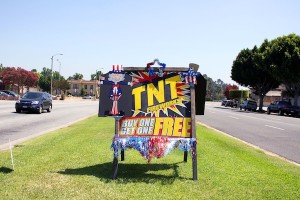If you venture out to Fourth of July weekend events around California, you’ll probably hear high talk about how Independence Day is a celebration of the things we Americans supposedly have in common: the same rights and freedoms and equality under the same laws.
Yeah, right—and I’m Thomas Jefferson.
If you want to know what the Fourth—and this nutty country—are really all about, head to the intersection of Huntington Drive and Alhambra Road in Southern California’s San Gabriel Valley. There, at the southeast corner, in front of Cheney’s Tropic Liquor and the 99 Cent Store, you’ll find a fireworks stand—one of hundreds that go up across California for a week each year.
In our bone-dry state, most fireworks—the kinds that explode and go airborne—are illegal to sell or possess. Which only makes sense. The public airwaves are full of warnings from the authorities—the same folks who like to talk about how we’re all equal before the law—against buying or setting off fireworks, lest you hurt yourself or burn your community down.
Of course, that is not the whole story. Liberty is never so simple. This week only, the state permits the sale of “safe and sane” fireworks—sparklers and things that don’t fly. Provided you are at least 16, you can buy such fireworks between noon on June 28 and noon on July 6; the sales fund local nonprofits (many raise more than $10,000 this week). But there is an important caveat: Cities and communities can choose to ban even “safe and sane” fireworks, and more than 200 of California’s nearly 500 municipalities have done so.
The result: California for eight days is a crazy quilt of fireworks sales and bans. And the intersection of Huntington and Alhambra is perhaps the best illustration of that. Three cities converge here. Two of them ban fireworks: Los Angeles (to the west of the intersection) and South Pasadena (to the north). But the third—the city of Alhambra—is a hotbed of fireworks sales.
 A sign advertising fireworks sits on the border of Alhambra (to the left) and the city of Los Angeles (to the right)
A sign advertising fireworks sits on the border of Alhambra (to the left) and the city of Los Angeles (to the right)
Indeed, the large fireworks stand sits on the Alhambra corner of the intersection, literally steps away from cities that have banned them. There are other fireworks stands in Alhambra near the city’s borders with San Marino and San Gabriel, which also have bans.
In these times, this may sound like another example of how our country is divided. The wise men of politics and punditry are currently afraid that America is too polarized, that we are splitting into red and blue nations. How, they ask, can we be the “One Nation Under God” the Founding Fathers intended if gay couples can get married in Boston but not in Birmingham?
In California, people in power are similarly worried about the political and economic divides between regions—especially the split between the liberal, prosperous coast and the conservative, struggling inland. We are also told that we are too often living among people who are too much like ourselves; we are said to be retreating into separate realities.
But would we truly be better off if our laws and freedoms were the same everywhere?
The fact that we have such different laws in different places can create peril: You can buy a dangerous firecracker or automatic weapon in one place and wreak havoc elsewhere. But it also makes us freer. If you have a little bit of time and the ability to travel, you can do just about anything in this country, for better and for worse. (Which is why fireworks—loud, volatile, powerful, dangerous—are such a fitting way of celebrating ourselves.)
We may even be less divided because of our differences. Remember that in California, our biggest political conflicts involve areas—taxes, prisons, water, and budgeting—where we all have to live under the same rules. We get along much better when our communities can go their own ways.
This idea—that American freedom would create crazy divides of all kinds, and that we shouldn’t get that upset about them—is an old one. “Liberty is to faction what air is to fire, an aliment without which it instantly expires,” wrote James Madison, who may have set off unpermitted fireworks in his day, in The Federalist Papers. “But it could not be less folly to abolish liberty, which is essential to political life, because it nourishes faction, than it would be to wish the annihilation of air, which is essential to animal life, because it imparts to fire its destructive agency.”
While Madison died long before California entered the Union, I suspect he would have felt vindicated by a Fourth of July in our state. He also might have been overwhelmed by all the choices at that fireworks stand in Alhambra. When I visited last weekend, there were dozens of individual fireworks options—the Mini Monster, the Purple Rain, Mad Dog Fountain, En Fuego, Black Widow, Orchid, Zombie Zapper—and combo packages all the way up to The Big Bang, which, for $500, appeared to provide enough firepower to allow me to wage war against San Diego.
I don’t care much for fireworks, but this stand supports an admirable band, the Mighty Moors of Alhambra High. And so I purchased a six-pack of Piccolo Petes, which produce a shrill whistle and gold sparks. So what if the neighbors call the cops or I set myself on fire? It’s the American way.
Originally published in Zocalo Public Square http://www.zocalopublicsquare.org/2014/07/03/how-fireworks-divide-california/inquiries/connecting-california/

